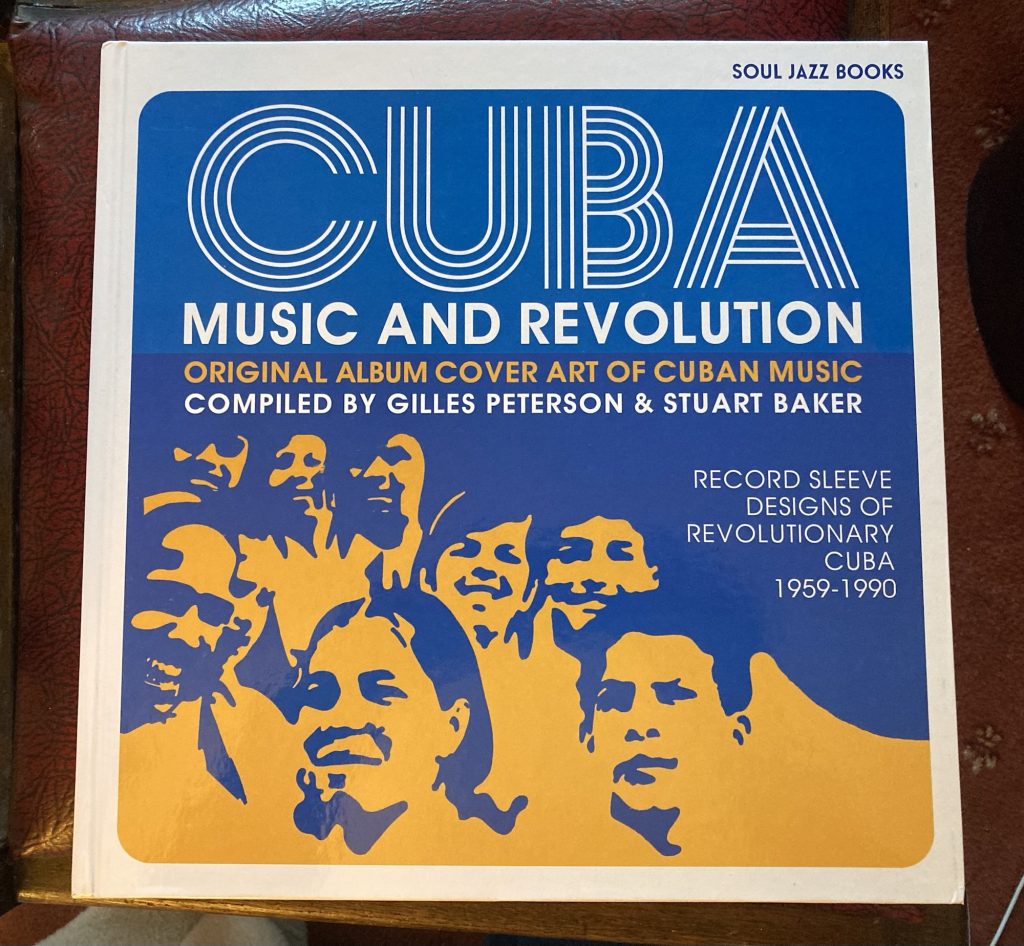

These two arrived today. And… wow! They’re terrific. I thought I’d bought the above a while back, but it turned out I’d got the CD that goes with it. Still not listened to the latter. High time I did!
One of the dangers, but also attractions, of acquiring such books, is the way they help one learn about and explore/expand one’s own music collection.
There are a decent number of albums pictured in here I already have, in one format or another. But there’s tons I neither have, nor have I even heard of.
This is also another spur towards getting the Sun Ra/Saturn album covers book, as he and his Arkestra and affiliates are well represented here.
One very striking thing that emerges from perusing this gorgeous time is the frequent juxtaposition of incredibly boldly colourful album cover spreads with starker black and white one. This occurs a lot! And is almost a unifying theme throughout.
The record covers run a pleasing and fascinating gamut, from the artistically and aesthetically sublime, to the less slick, more DIY aesthetic. The latter prefigures the anarchic energy of punk. A parallel the book is keen to highlight.
I haven’t started digging into the text yet. I’ve just bathed in the visual glory of the photographic content. Which is a very enjoyable and rewarding thing to do. But from what I have read, it promises to be a compelling and enlightening read.
One thing that intrigues me, is how certain labels feature, some very heavily – e.g. Strata East, Muse, Flying Dutchman – whilst others that might have – I’m thinking particularly of Bob Shad’s Mainstream – don’t.
It’s also interesting that in all the Soul Jazz books on record cover artwork – they don’t continue into the age of CDs, by and large – there is a string political dimension. Brazil had the military dictatorship in the ‘70s. Cuba has been and remains under embargo, as a Communist outlier on the US doorstep, and this book and its subjects are steeped in the long running politics of race, and ‘black identity’, as they’ve persisted in America.
All in all, an absolutely wonderful book, on a fascinating subject. Well worthy of this treatment. And ripe for exploration and appreciation.


As with all the Soul Jazz titles in this line – Freedom Rhythm & Sound, Bossa Nova, etc. – this is beautifully put together and presented.
I got the hardback version, in this instance. Alas, the hardback edition of FR&S was too pricey. So I’ve only got the paperback of that one. But both editions are beautiful. A perfect size (near enough LP sized, befitting the subject), and beautifully printed.
One aspect of this book that initially bothered me, and still niggles a bit, in truth, is how specialist and niche they’ve made it, by confining it purely to Cuban indigenous releases.
I suppose opening it up to a wider base, in particular I’m thinking of US Cuban or Cuban-influenced stuff, might’ve made it too large in scale and scope? As it stands, the choice to stay ‘at home’ in Cuba makes it rather more niche, to my mind.
The result of this is that Cuban emigres often only appear here during their time in the ‘mother country’ (eg Chucho Valdez), or sometimes (Patato Valdez, for example) not at all.
This also means that a label like Fania – whose very name is taken from a ‘popular luncheonette frequented by musicians in Havana, … that [label founder] Masucci frequented when he worked for a public relations firm there during the pre-Castro era’ – is not covered here.
If I was being fussy or curmudgeonly I’d dock a star for this. But, truth be told, within the ‘Revolution’ remit the book sets for itself, this remains a wonderful and fascinating treasure trove of musical history.
It’s intriguing that once again, as with other Soul Jazz record cover art books, there’s a string political angle, to the subject. Unsurprisingly, this means there’s some ‘party lines’ type stuff that’s either a bit weird, or rather heavily programmatic. What’s more surprising, perhaps, is the overall freedom of expression within the Cuban music scene as a whole.
As befits an island known for its musical exoticism, and associated forms of hedonism popular with tourists, the album covers reflect a culture that is colourful, vibrant, diverse and highly exciting.
This is art from a decidedly Communist nation. But it’s certainly not purely the kind of dour ‘party sanctioned’ propaganda one might associate with other Communist regimes.
As with the FR&S title, at present I’m just varying in the warming glory of the visual content. Other than reading the intros, I’ve yet to dive into the textual parts. They appear on first glance to promise a fascinating and informative read.
One major difference, however, ‘twixt my experience relating to these books, is that whilst I have quite a number of CDs (and other stuff) that are illustrated in FR&S, I have closer to bone that are feature in this book.
I’ve got a little tiny bit of stuff by some of the artists who appear here – Irakere, Los Van Van, Tata Guines, Omara Portuando, for example. But the vast bulk of what’s illustrated here is music I don’t have or know.
Of the two books under review in this post, FR&S is the closer to my own musical heart, I think? Both will – indeed already do – make me want to explore the music they represent more. But that’s all to the good, excepting only potential fiscal fallout!
